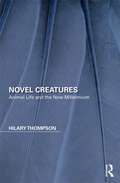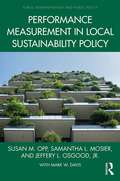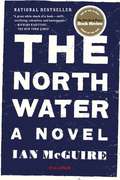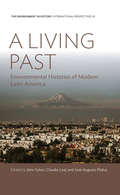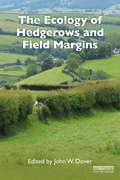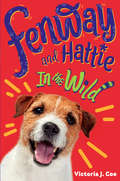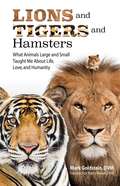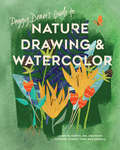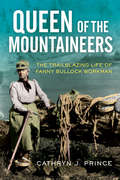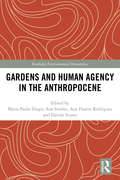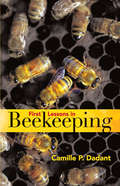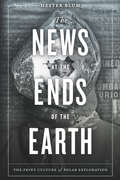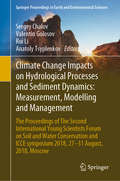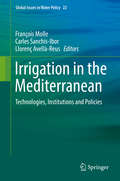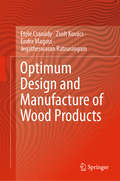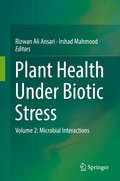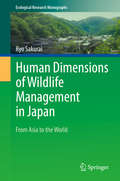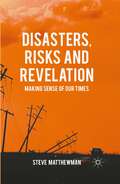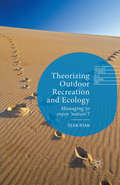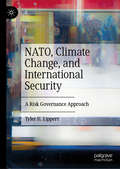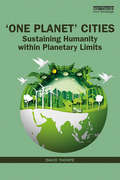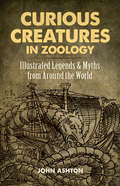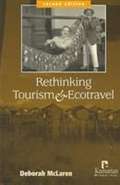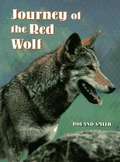- Table View
- List View
Novel Creatures: Animal Life and the New Millennium (Perspectives On The Non-human In Literature And Culture Ser.)
by Hilary ThompsonNovel Creatures takes a close look at the expanding interest in animals in modern fiction and argues that the novels of this time reveal a dramatic shift in conceptions of "creatureliness." Scholars have turned to the term "creaturely" recently to describe shared aspects of human and animal experience, thus moving beyond work that primarily attends to distinctions between the human and the animal. Carrying forward this recent scholarship, Novel Creatures argues that creatureliness has been an intensely millennial preoccupation, but in two contrasting forms—one leading up to the turn of the century, the other after the tragic events of 9/11.
Performance Measurement in Local Sustainability Policy (Public Administration and Public Policy)
by Susan M. Opp Samantha L. Mosier Jeffery L. Osgood, Jr.Local officials are responsible for a number of important tasks that have a significant impact on the quality of life of most Americans. Arguably, the policy choices made by local governments in the United States more directly impact individual well-being than do the choices made at any other level of government. From zoning decisions to the creation of parks and the maintenance of sidewalks and trails, local governments are largely responsible for direct services to the public and can provide the necessary tools and skills to create an attractive and vibrant community. And yet one area of significant importance for both individuals and for the country as a whole, local sustainability, is a relatively new policy area for many American municipalities. For example, how many local governments are adopting sustainability policies and plans? How are those initiatives performing? Without an honest and robust examination of both the effectiveness and the efficiency of local sustainability policies, the success of the entire sustainability movement in the United States is uncertain. This book provides readers with a comprehensive understanding of what constitutes local sustainability and why it matters. Focusing closely on environmental initiatives, economic development issues, and social equity concerns, each chapter offers both an account of the sustainability policies being adopted and a close exploration of the performance measurement activities of cities in that policy area. Readers are introduced to the metrics that American cities are using to measure the performance of their sustainability efforts, as well as benchmarks and comparison statistics that may be used to develop and evaluate the performance assessment efforts in their own sustainability programs. Students of public administration, urban planning, and political science – as well as public officials – will find this book useful to understand the complexity of sustainability and local government.
The North Water: A Novel
by Ian Mcguire<P>A nineteenth-century whaling ship sets sail for the Arctic with a killer aboard in this dark, sharp, and highly original tale that grips like a thriller. <P>Behold the man: stinking, drunk, and brutal. Henry Drax is a harpooner on the Volunteer, a Yorkshire whaler bound for the rich hunting waters of the arctic circle. Also aboard for the first time is Patrick Sumner, an ex-army surgeon with a shattered reputation, no money, and no better option than to sail as the ship's medic on this violent, filthy, and ill-fated voyage. <P>In India, during the Siege of Delhi, Sumner thought he had experienced the depths to which man can stoop. He had hoped to find temporary respite on the Volunteer, but rest proves impossible with Drax on board. <P>The discovery of something evil in the hold rouses Sumner to action. And as the confrontation between the two men plays out amid the freezing darkness of an arctic winter, the fateful question arises: who will survive until spring? <P>With savage, unstoppable momentum and the blackest wit, Ian McGuire's The North Water weaves a superlative story of humanity under the most extreme conditions. <P><b>A New York Times Bestseller</b>
A Living Past: Environmental Histories of Modern Latin America (Environment in History: International Perspectives #13)
by John Soluri Claudia Leal José Augusto PáduaThough still a relatively young field, the study of Latin American environmental history is blossoming, as the contributions to this definitive volume demonstrate. Bringing together thirteen leading experts on the region, A Living Past synthesizes a wide range of scholarship to offer new perspectives on environmental change in Latin America and the Spanish Caribbean since the nineteenth century. Each chapter provides insightful, up-to-date syntheses of current scholarship on critical countries and ecosystems (including Brazil, Mexico, the Caribbean, the tropical Andes, and tropical forests) and such cross-cutting themes as agriculture, conservation, mining, ranching, science, and urbanization. Together, these studies provide valuable historical contexts for making sense of contemporary environmental challenges facing the region.
The Ecology of Hedgerows and Field Margins
by John W. DoverHedges and field margins are important wildlife habitats and deliver a range of ecosystem services, and their value is increasingly recognised by ecologists. This book reviews and assesses the current state of research on hedgerows and associated field margins. With the intensification of agriculture in the second half of the last century, field sizes were increased by amalgamation and the rooting out of hedges, synthetic pesticide and inorganic fertiliser use increased, and traditional methods of hedge management were largely abandoned. The book is split into two main sections. The first deals with definitions, current and historic management, the impact of pesticides, the decline in hedge stock and condition, and new approaches to hedge evaluation using remote sensing techniques. The second section explores the pollination and biological pest control benefits provided by hedges and field margins and examines the ecology of some of the major groups that are found in hedgerows and field margins: butterflies and moths, carabid beetles, mammals, and birds. A case study on birds and invertebrates from a research farm managed as a commercial enterprise, but which attempts to farm with wildlife in mind, brings these themes together. A final chapter introduces the neglected area of hedges in the urban environment. The book will be of great interest to advanced students, researchers and professionals in ecology, agriculture, wildlife conservation, natural history, landscape, environmental and land management.
Fenway and Hattie in the Wild (Fenway and Hattie #4)
by Victoria J. CoeIn the fourth book in the adorable middle-grade series, Fenway gets a taste of the wild when he goes on a back-to-school camping trip with Hattie. When Hattie starts using a word Fenway hasn't heard in a long, long time - "skool" - some other things change as well. Hattie's bushy ponytail disappears, clothes that smell like no one ever wore them get tossed around her room, and she smells nervous much more than usual. Then the family fills the Food Box with yummy hot dogs and loads it in the car. Fenway is thrilled that he gets to go along where ever they are going, and is even more excited when they arrive in the wilderness with tons of new scents to investigate, dogs and humans to meet, and lots of meat cooking over fires. Hattie seems excited about it all, too, and happy her friend Angel also came, but when more families arrive with lots of new kids, she smells nervous again. Especially when one certain kid that all the others seem to follow everywhere starts bossing everyone around. Fenway can sympathize, because a tiny dog is doing the same thing to all the other dogs. Fitting in can be a tough business, but luckily both Fenway and Hattie come around to realizing that being true to themselves is much more important.
Lions and Tigers and Hamsters: What Animals Large and Small Taught Me About Life, Love, and Humanity
by Dr. Mark GoldsteinFrom the time Dr. Mark Goldstein was a little boy—even before he had his first dog—he was fascinated by creatures both domestic and wild. After graduating veterinary school at Cornell University, he became a veterinarian in clinical practice, then director of zoos in Boston and Los Angeles, then head of a progressive humane society where he advocated for animal welfare. During his extraordinary 30-year career, Dr. Mark has accrued a lifetime of experiences working with all sorts of animals and the people who care for them. Dr. Mark's life with animals taught him more than how to be a great doctor, it taught him how to live life. The stories in this book reflect those lessons; they will make you laugh and cry as they entertain and amaze you. Each real-life experience sheds light on the challenges and hard work of the talented individuals who work in the world of animal welfare. These are stories that illustrate the tremendous impact animals have on our daily lives—they are hallmarks of the sacred importance of the human-animal bond. On your journey through the exhilarating life of Dr. Mark, you'll meet some of the finned, furred, and feathered animals who offered him invaluable insights—Harold the hamster, Sasha the Siberian tiger, St. Francis the German Shepherd, Ralph the buffalo, Gus the stallion, Frank the goldfish, and many more fascinating creatures!
Peggy Dean's Guide to Nature Drawing and Watercolor: Learn to Sketch, Ink, and Paint Flowers, Plants, Trees, and Animals
by Peggy DeanThis fun and easy-to-use nature drawing and watercolor guide is perfect for anyone inspired by nature to draw, doodle, ink, and paint colorful flora and fauna. Artist, author, and popular art instructor Peggy Dean presents this nature drawing guide that teaches you how to master drawing and watercolor techniques from sketching and shading to washes and blending. With Peggy's easy and energetic lessons, absolutely anyone--regardless of ability--can learn to draw the natural world. Beginning with delicate cherry blossoms, wildflowers, and lacy ferns, lessons build to composing stunning bouquets of flowers and majestic landscapes. You'll also discover how to draw animals such as colorful fish and birds in flight, as well as mammals like stoic camels and the mighty polar bear. Through the lessons on technique combined with clear, detailed instructions, you'll gain the expertise and confidence that will allow you to quickly build your skills, discover your own personal style, and achieve beautiful botanical and animal illustrations.
Queen of the Mountaineers: The Trailblazing Life of Fanny Bullock Workman
by Cathryn J. PrinceFanny Bullock Workman was a complicated and restless woman who defied the rigid Victorian morals she found as restrictive as a corset. With her frizzy brown hair tucked under a topee, Workman was a force on the mountain and off. Instrumental in breaking the British stranglehold on Himalayan mountain climbing, this American woman climbed more peaks than any of her peers, became the first woman to map the far reaches of the Himalayas, the first woman to lecture at the Sorbonne and the second to address the Royal Geographic Society of London, whose members included Charles Darwin, Richard Francis Burton, and David Livingstone. Her books, replete with photographs, illustrations and descriptions of meteorological conditions, glaciology and the effect of high altitudes on humans, remained useful decades after their publication. Paving the way for a legion of female climbers, her legacy lives on in scholarship prizes at Wellesley, Smith, Radcliffe and Bryn Mawr.Author and journalist Cathryn J. Prince brings Fanny Bullock Workman to life and deftly shows how she negotiated the male-dominated world of alpine clubs and adventure societies as nimbly as she negotiated the deep crevasses and icy granite walls of the Himalayas. It's the story of the role one woman played in science and exploration, in breaking boundaries and frontiers for women everywhere.
Gardens and Human Agency in the Anthropocene (Routledge Environmental Humanities)
by Maria Paula Diogo Ana Duarte Rodrigues Ana Simões Davide ScarsoThis volume discusses gardens as designed landscapes of mediation between nature and culture, embodying different levels of human control over wilderness, defining specific rules for this confrontation and staging different forms of human dominance. The contributing authors focus on ways of rethinking the garden and its role in contemporary society, using it as a crossover platform between nature, science and technology. Drawing upon their diverse fields of research, including History of Science and Technology, Environmental Studies, Gardens and Landscape Studies, Urban Studies, and Visual and Artistic Studies, the authors unveil various entanglements woven in the past between nature and culture, and probe the potential of alternative epistemologies to escape the predicament of fatalistic dystopias that often revolve around the Anthropocene debate. This book will be of great interest to those studying environmental and landscape history, the history of science and technology, historical geography, and the environmental humanities.
Gunsmithing Modern Firearms: A Gun Guy's Guide to Making Good Guns Even Better
by Bryce M. TowsleyOne of America's foremost experts on gunsmithing, Bryce Towsley is back again to provide even more projects for anyone interested in building, customizing, or maintaining firearms. He offers detailed explanations and includes color illustrations for just about every aspect of gun modification and repair. Featured tutorials include: stock modifications, accuracy enhancement, weather preparation, a total rifle makeover, and much more. Beginning with shop design and maintenance, Towsley builds on the knowledge he provides until ending with directions on rifle building from scratch. For anyone interested in fixing or building guns, Towsley’s new book is the best guide to getting the most out of a rifle through personal modifications.“My experience working with Skyhorse is always a positive collaboration. The editors are first-rate professionals, and my books receive top-shelf treatment. I truly appreciate our working relationship and hope it continues for years to come.” –David Fischer, author
First Lessons in Beekeeping
by Camille Pierre DadantIn light of the dwindling honey bee population, this century-old guide is more relevant than ever. Written by the scion of a celebrated family of beekeepers that continues to operate today, the richly illustrated volume is the perfect companion for beginning beekeepers as well as those with a casual interest in bees. Reader-friendly information ranges from background on bee anatomy and the social structure of bee communities to different types of hives and how they function, honey production, wintertime beekeeping, and other practical matters. Author Camille Pierre Dadant was the son of Charles Dadant, one of the fathers of modern beekeeping techniques, inventor of the Dadant beehive, and founder of one of the first beekeeping equipment manufacturers. The business is still extant and run by the family, as is their publication, American Bee Journal. The old-fashioned charm of Dadant's narrative rests upon a solid foundation of timeless scientific knowledge, complemented by many informative drawings and photographs.
The News at the Ends of the Earth: The Print Culture of Polar Exploration
by Hester BlumFrom Sir John Franklin's doomed 1845 search for the Northwest Passage to early twentieth-century sprints to the South Pole, polar expeditions produced an extravagant archive of documents that are as varied as they are engaging. As the polar ice sheets melt, fragments of this archive are newly emergent. In The News at the Ends of the Earth Hester Blum examines the rich, offbeat collection of printed ephemera created by polar explorers. Ranging from ship newspapers and messages left in bottles to menus and playbills, polar writing reveals the seamen wrestling with questions of time, space, community, and the environment. Whether chronicling weather patterns or satirically reporting on penguin mischief, this writing provided expedition members with a set of practices to help them survive the perpetual darkness and harshness of polar winters. The extreme climates these explorers experienced is continuous with climate change today. Polar exploration writing, Blum contends, offers strategies for confronting and reckoning with the extreme environment of the present.
Climate Change Impacts on Hydrological Processes and Sediment Dynamics: The Proceedings of The Second International Young Scientists Forum on Soil and Water Conservation and ICCE symposium 2018, 27–31 August, 2018, Moscow (Springer Proceedings in Earth and Environmental Sciences)
by Sergey Chalov Valentin Golosov Rui Li Anatoly TsyplenkovThis book offers a collection of conference articles presented at the Second International Young Scientists Forum on Soil and Water Conservation and ICCE symposium 2018 “Climate Change Impacts on Sediment Dynamics: Measurement, Modelling, and Management” held at Moscow from 27 to 31 August 2018. This conference was organized by World Association of Soil and Water Conservation (WASWAC) and Lomonosov Moscow State University in cooperation with the International Commission on Continental Erosion of the International Association of Hydrological Sciences and World Large rivers Initiative. Topics in this book cover a wide range of questions related to fluvial geomorphology, water studies, and sediment transport.
Irrigation in the Mediterranean: Technologies, Institutions and Policies (Global Issues in Water Policy #22)
by François Molle Carles Sanchis-Ibor Llorenç Avellà-ReusMediterranean irrigation is diverse due to, among other factors, the relative importance of water in the economy of each country, varied levels of aridity, heterogeneous levels economic, social and technological levels of development, and differences in political and social organization. However, most of the Mediterranean countries face similar problems to meet their water demands because of the scarcity and variability of renewable resources, growing water requirements from non-agricultural sectors, increasing environmental concerns related to water quality and environmental degradation, a social demand for larger public participation, and important technological changes. The time has come to reconsider the “not one drop lost to the sea” philosophy of yesteryears largely and to 'live within limits'.This book focuses on eight selected countries (Tunisia, Morocco, Spain, France, Italy, Turkey, Israel and Egypt) and provides a comparative perspective that both thoroughly explores their specificities and identifies the common challenges faced by the irrigation sector in these countries. The book has been written at a critical moment, when the continued application of a supply-side water management model is revealing its unsustainable nature in numerous places; when significant technological changes are taking place in the irrigation sector; when new forms of management and governance are widely held as badly needed; and finally, when climate change is compounding many of the difficulties that have characterized irrigation policies and practices in the past decades.This complicated future context makes Mediterranean irrigation face various political dilemmas on water management, raising social tensions, triggering territorial and land conflicts, and stimulating new technological developments. This book provides a timely analysis of the particular trajectory of eight Mediterranean countries in these uncertain transformations, and attempts to identify the best strategies to avert or overcome future risks.
Optimum Design and Manufacture of Wood Products
by Jegatheswaran Ratnasingam Endre Magoss Zsolt Kovács Etele CsanádyThis monograph presents state-of-the-art knowledge in wood manufacturing design with a special focus on the elaboration of functional relationships. The authors transfer and apply the method of functional relationships to challenges in wood manufacturing, and the book contains many worked examples which help the reader to better understand the presented method. The topical spectrum includes machining processes, energy consumption, surface quality, hardness and durability properties as well as aesthetical properties. The target audience primarily comprises research experts and practitioners in wood manufacturing, but the book may also be beneficial for graduate students alike.
Plant Health Under Biotic Stress: Volume 2: Microbial Interactions
by Rizwan Ali Ansari Irshad MahmoodThe book illustrates the use of putative microbial agents which provide good protection to the plant from biotic pathogens attack. An up to date knowledge on plant-microbiome interaction strategies in terms of improved sustainability has been discussed. Information from experts across the globe on the application of microbes for providing amicable solution in sustainable agriculture has been gathered. In addition, information related to microbes mediated resistance levels leading to enhanced plant health has been well presented. The chapters have emphasised the use of Plant Growth Promoting Rhizobacteria (PGPR) and other potential biocontrol agents/antagonists in the management of plant diseases which provide extensive information to the readers. Literature on microbial root colonization, plant growth promotions, and also on the protection of plants from attack of various soil borne pathogens have been presented in a coherent way. Information on the application of potential strain of the bio-control fungi, endophytes, actinomycetes strengthening the plants ability which rescue the plant from pathogens attack leading to improved plant health has also been underpinned.
Human Dimensions of Wildlife Management in Japan: From Asia to the World (Ecological Research Monographs)
by Ryo SakuraiThis book discusses the findings of research on the human dimensions of wildlife management conducted in Japan, demonstrating how such research and approaches have contributed to mitigating human-wildlife conflicts.Human-wildlife conflicts, including agricultural and property damage as well as occasional casualties, are a global problem for which local residents, managers, and stakeholders around the world are struggling to find solutions. Human dimensions of wildlife management (HDW) is an academic field developed in North America in the 1970s to gather information on the social aspects of human-wildlife issues to help wildlife managers and stakeholders implement effective decision-making measures. However, HDW is not widely recognized or applied outside North America, and few studies have investigated whether HDW approaches would be effective in different cultural settings.This is the first book written in English to introduce the HDW theories and practices implemented in Asia. Presenting innovative approaches and research techniques, as well as tips on how to introduce HDW methods into culturally different societies, it is a valuable resource not only for researchers and students in this field, but also for government officials/managers, NGOs, residents and other stakeholders who are affected by human-wildlife conflicts around the globe.
Disasters, Risks and Revelation: Making Sense of Our Times
by Steve MatthewmanDisasters are part of the modern condition, a source of physical anxiety and existential angst, and they are increasing in frequency, cost and severity. Drawing on both disaster research and social theory, this book offers a critical examination of their causes, consequences and future avoidance.
Theorizing Outdoor Recreation and Ecology (Leisure Studies in a Global Era)
by Sean RyanDeciding what user impacts are natural or unnatural has inspired much debate. Biophysically, moose cause similar kinds of soil and vegetation impacts as hikers. Yet moose are the sign of nature while hikers are the sign of damage. The field of outdoor recreation is beset with paradoxes, and this book presents a unique, alternative framework to address these dilemmas. Examining outdoor recreation through the lens of ecological theory, Ryan draws from theorists such as Foucault, Derrida and Latour. The book explores minimum impact strategies designed to protect and enhance ecological integrity, but that also require a disturbing amount of policing of users, which runs counter to the freedom users seek. Recent ecological theory suggests that outdoor recreation's view of nature as balanced when impacts are removed is outdated and incorrect. What is needed, and indeed Ryan presents, is a paradoxical and ecological view of humans as neither natural nor unnatural, a view that embraces some traces in nature.
NATO, Climate Change, and International Security: A Risk Governance Approach
by Tyler H. LippertThis book offers a prospective analysis of the anticipated security consequences of climate change in relation to the North Atlantic Treaty Organization (NATO). Using climate and security literature to complement recent foresight and scenario analysis developed by NATO, the author applies the International Risk Governance Council’s (IRGC) Risk Governance Framework to identify the considerations and actions that could assist NATO in a context where climate and environmental factors more intensively shape security. Tyler Lippert explores how climate change has the potential to increase the need for humanitarian assistance and disaster response, to create tension over shared resources, to renew and enhance geo-political interest in the Arctic, and to deepen concern with respect to the Middle East and North Africa (MENA). Within this new political and environmental reality, NATO must consider how to adapt to meet new demands, prepare for new security challenges, as well as manage unforeseen consequences. Offering a corrective, this book identifies near-term actions for NATO to improve its risk governance posture, providing a basis upon which longer-range policy considerations can be developed. This analysis is only the opening salvo of what is likely to be a complicated process that spans many years, if not decades. However, in mapping the risk governance dimensions to the security and climate nexus from the perspective of NATO, Lippert provides a foundation for risk-based policy planning for NATO. The book will be of immense value to policy and decision makers: NATO leadership and its affiliated organizations as well as to academics across a broad span of subject areas, particularly environmental sociology, defense and foreign policy, and the political sciences.
'One Planet' Cities: Sustaining Humanity within Planetary Limits
by David ThorpeThis book addresses the crucial question of how the essential needs of the growing human population can be met without breaking the Earth's already-stretched life-support system. With four out of five people predicted to be urban dwellers by 2080, ‘One Planet’ Cities proposes a pathway to genuine sustainability for cities and neighbourhoods, using an approach based on contraction and convergence. Utilising interviews with key players, including the Global Footprint Network, World Future Council, WWF, mayors and government officials, and case studies from across the globe, including Europe, North and South America, Australia, South Africa, China and India, David Thorpe examines all aspects of modern society from food provision to neighbourhood design, via industry, the circular economy, energy and transport through the critical lens of the ecological footprint and relevant supporting international standards and indicators. Recommendations on managing supply chains and impacts, how the transition to a world within limits might be financed, and a deep examination of the Welsh Government's pioneering efforts follow. It concludes with an imagined vision of what a genuinely sustainable future might be like, and an appeal for 'one planeteers' everywhere to step up to the challenge. This book will be of great interest to practitioners and policymakers involved in governance, administration, urban environments and sustainability, alongside students of the built environment, urban planning, environmental policy and energy.
Curious Creatures in Zoology: Illustrated Legends and Myths from Around the World
by John AshtonRather than a work of science, this richly illustrated volume offers fare for the imagination with its fascinatingly odd menagerie. Historical accounts of centaurs, unicorns, and lesser-known fantastical creatures provide abundant amusement.
Rethinking Tourism and Ecotravel
by Deborah McLarenA fully revised and comprehensive overview of the history and global development of tourism, often considered the largest industry in the world. Despite promising great benefits to hosts and guests alike, tourism has often resulted in some very stark and painful consequences for local host communities and the environment.
Journey of the Red Wolf, First Edition
by Roland SmithThe story of the red wolf's journey from the brink of extinction to its reintroduction to the wild follows the endeavors of the Red Wolf Recovery Program, from the 1971 capture of seventeen endangered wolves to their joyful release.
